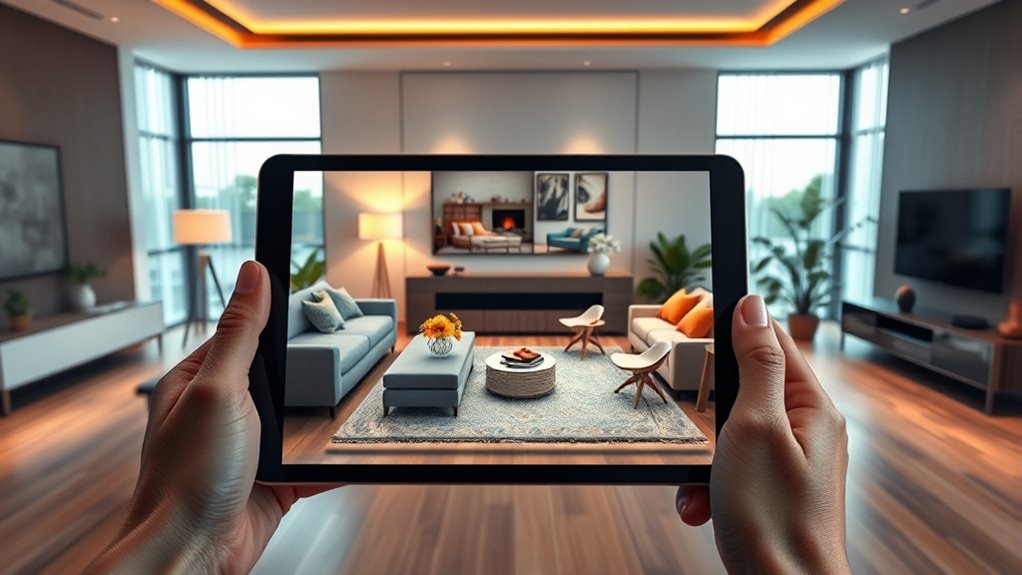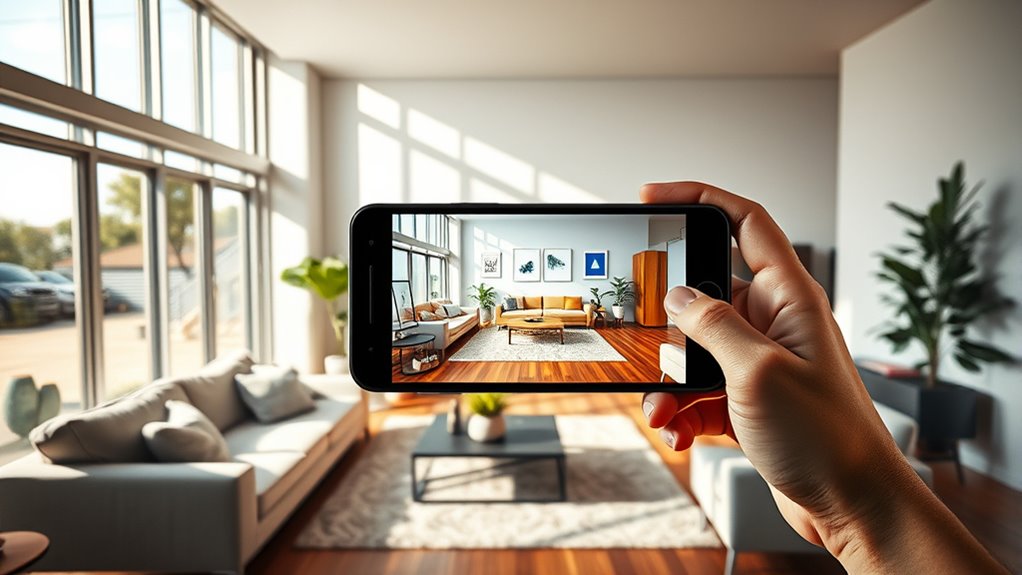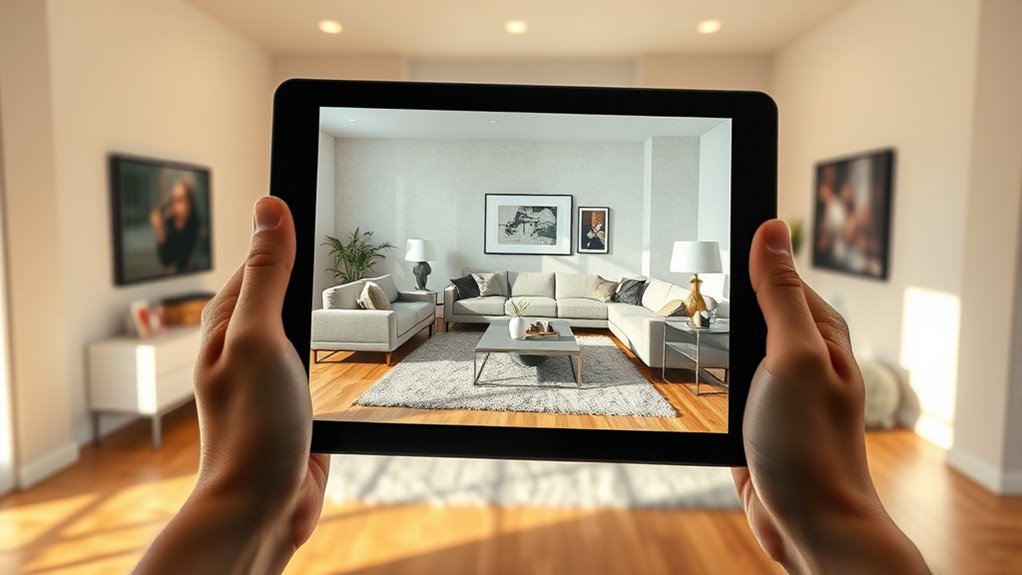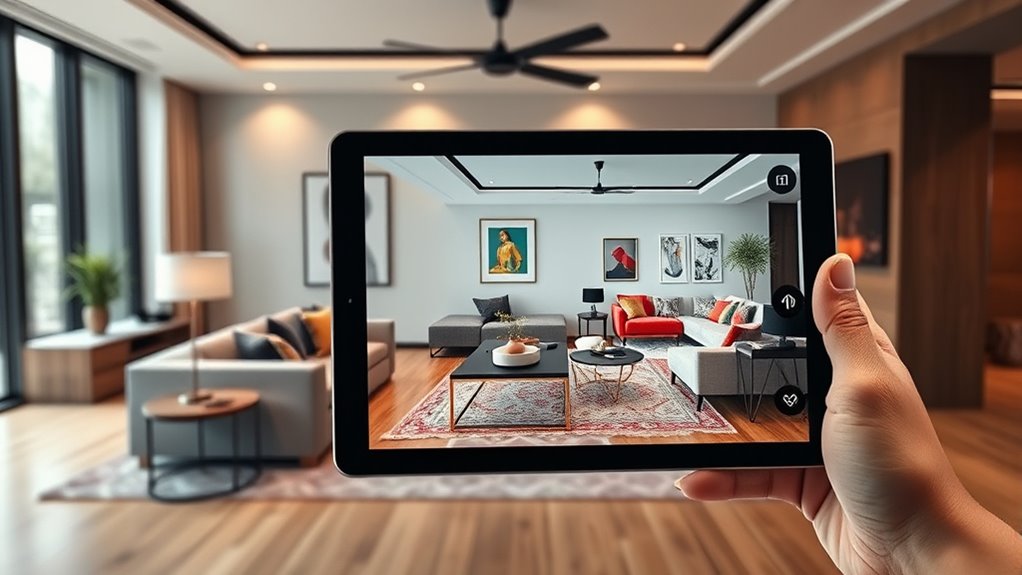To integrate AR for virtual room makeovers, start by selecting tools with advanced spatial mapping and environment detection, like LiDAR or depth cameras. Use design software that allows real-time virtual overlays aligned with real surfaces. Incorporate AI to analyze room features and personalize suggestions. Guarantee your app has an intuitive interface with calibration steps for accurate placement and lighting simulation. Keep refining your setup for seamless user experience—more tips to help you master the process await you.
Key Takeaways
- Utilize advanced sensors like LiDAR and depth cameras for accurate spatial mapping of the room.
- Implement AI algorithms to detect room boundaries, furniture, and environmental features for precise virtual integration.
- Develop an intuitive user interface with real-time overlays for seamless furniture placement and customization.
- Calibrate AR devices with reference points and grid patterns to ensure accurate alignment across lighting conditions.
- Incorporate lighting simulation and material textures to enhance realism and help users visualize design changes effectively.
Understanding the Core Components of AR Interior Design

To effectively utilize AR in interior design, grasping its core components is vital. AR interior design relies on virtual overlays that seamlessly merge digital elements with the real environment, offering a realistic view of potential changes. Design software and visualization tools enable you to create detailed 3D modeling, helping clients visualize furniture, layouts, and decor accurately. Interactive interfaces allow real-time modifications, making adjustments quick and intuitive. Environment tracking ensures virtual objects stay fixed within the physical space, maintaining alignment as you move around. Moreover, spatial mapping is essential for precise placement and interaction of virtual elements within the physical environment. Additionally, understanding ethical considerations in AR implementation ensures responsible use of technology and data privacy. Incorporating user experience principles is also crucial for creating intuitive and engaging virtual interactions. An understanding of retail hours can also be beneficial for planning client visits or demonstrations, especially when coordinating with physical stores or service providers. Staying informed about AI security developments can help safeguard client data and ensure trustworthy virtual design experiences. Together, these components empower you to craft immersive, precise virtual room makeovers that transform your design process.
Designing a User-Friendly AR App for Room Makeovers

Creating a user-friendly AR app for room makeovers involves designing an intuitive interface that anyone can navigate with ease. Focus on a simple user interface with clear icons, minimal steps, and intuitive navigation to cater to all skill levels. Incorporate real-time overlays that instantly visualize furniture and décor changes, boosting confidence in decisions. Guarantee device compatibility across iOS and Android, supporting quick scene scanning, adjustable lighting, and high-quality 3D rendering for realistic previews. Enable effortless customization using drag-and-drop tools, preset themes, and adjustable parameters like color schemes and furniture sizes. To help users get started, include guided tutorials, visual prompts, and seamless onboarding. Incorporating mindfulness techniques into the app’s design—such as calming color schemes and gentle guiding prompts—can enhance user experience and reduce decision fatigue, ensuring a smooth virtual room makeover experience. Additionally, emphasizing accessibility features can make AR technology more inclusive for users with diverse needs, promoting broader engagement and confidence in using the app. Incorporating user feedback during development can further refine features and usability to better meet diverse user needs. Implementing adaptive interfaces that adjust to user preferences and skill levels can further personalize the experience and foster greater satisfaction. As the integration of automation and AI continues to evolve, designing with user-centered principles ensures that the technology remains accessible and beneficial for all users.
Incorporating AI and Spatial Mapping for Customization

By integrating AI with AR spatial mapping, you can automatically detect room boundaries, furniture, and features for precise virtual customization. AI analyzes your space in real-time to recommend design options tailored to your layout and preferences. This combination guarantees virtual objects fit perfectly and adapt dynamically to your environment. Additionally, understanding privacy policies related to data collection is essential to ensure your information remains protected during the process. Utilizing AI’s ability to interpret spatial data enhances the accuracy and realism of virtual room makeovers, providing a seamless experience from start to finish. Incorporating real-time analysis allows for adjustments to be made instantly, further improving the customization process. Moreover, selecting portable power sources like power banks or solar panels can ensure your devices stay charged throughout your design sessions, especially when working outdoors or in locations with limited power access. Being aware of dog breed characteristics can also help in customizing the environment to suit specific needs or preferences for pet-friendly spaces.
AI-Driven Design Personalization
AI-driven design personalization transforms virtual room makeovers by analyzing your preferences through advanced machine learning algorithms. By combining AI-driven personalization with spatial mapping, the system creates accurate 3D room models that enable precise virtual furniture placement and layout adjustments. Use of materials as well as design trends can be incorporated into the virtual environment, providing a comprehensive understanding of aesthetic choices. As you interact, real-time adjustments cater to your evolving needs, offering tailored design recommendations based on your user preferences, style trends, and environmental factors. This integration allows you to visualize customized decor, color schemes, and furniture options, enhancing the immersive virtual experience. The technology adapts seamlessly, providing highly personalized suggestions that reflect your unique taste, making your virtual room makeover both realistic and engaging. Additionally, incorporating popular juice brands and healthy beverage options can inspire you to create a vibrant, refreshing atmosphere in your redesigned space. Understanding asset division laws plays a crucial role in ensuring your virtual design choices are aligned with current legal considerations, especially when planning shared spaces or investments. Integrating spatial mapping allows for highly accurate representations of your existing environment, ensuring the virtual modifications are both precise and practical. With AI-driven design personalization, you get a truly customized space that aligns perfectly with your vision.
Precise Spatial Environment Mapping
Precise spatial environment mapping builds on personalized design by capturing the exact layout and features of your space through advanced sensors like LiDAR and depth cameras. These sensors gather detailed data to create accurate 3D models of your environment, including environmental features and furniture placement. AI algorithms analyze this data to identify room boundaries and environmental details, ensuring your virtual furniture fits perfectly. Real-time processing updates the environment model dynamically, accommodating changes in room layout or lighting. This foundation enhances visualization fidelity and boosts your confidence in design choices. Additionally, integrating remote work principles can help optimize your space for productivity and comfort. Incorporating further technological advancements can elevate the accuracy and usability of your virtual makeover experience. Employing sensor calibration techniques ensures the precision of environmental data, further improving the virtual integration process.
Adaptive Virtual Object Placement
Adaptive virtual object placement harnesses spatial mapping data from AR devices to seamlessly integrate virtual elements into your space. By analyzing room dimensions, surfaces, and existing furniture through environment detection, the system guarantees precise virtual object placement. AI algorithms evaluate your preferences and room characteristics, enabling dynamic customization of virtual objects’ size, style, and position. Real-time updates adjust virtual elements automatically as you move furniture or change the layout, maintaining accurate alignment and immersion. Advanced placement algorithms consider lighting, clearance, and aesthetic balance to optimize object positioning. This combination of AI and spatial mapping enhances the adaptability of your virtual room, providing personalized, precise, and context-aware virtual object arrangements that elevate your virtual makeover experience. Additionally, understanding local store hours, such as supermarket hours today, can help coordinate shopping trips around your virtual room planning sessions.
Enhancing Visualization With Lighting and Material Simulations

By using AR technology to simulate different lighting conditions and materials, you can see how various choices will influence your room’s look and feel in real time. Lighting simulation allows you to preview natural daylight or artificial fixtures, helping you optimize room ambiance and color perception. Material overlay lets you visualize textures like wood, fabric, or tile, providing a texture preview that enhances design accuracy. AR visualization highlights potential glare, shadows, and color inconsistencies, ensuring your selections translate well in the virtual environment. Additionally, modeling energy-efficient lighting scenarios shows how fixtures and placements impact brightness and consumption. This hands-on approach streamlines decision-making, reduces costly mistakes, and guarantees your final design aligns with your vision before any physical changes occur.
Testing and Refining the AR Experience for Accuracy and Ease of Use

To guarantee your AR experience is both accurate and user-friendly, you need to focus on calibration and alignment checks. Optimizing the user interface also plays a vital role in making interactions smooth and intuitive. Regular testing and feedback help you identify issues early and refine the system effectively.
Calibration and Alignment Checks
Have you ever wondered how AR systems guarantee virtual furniture stays aligned with real-world surfaces? It all starts with proper calibration, which ensures accurate tracking of environment surfaces. Regular calibration refines the alignment between the AR overlay and physical features, using reference points or grid patterns to verify that virtual furniture matches environment surfaces precisely. Alignment checks involve testing the AR experience across different lighting conditions to identify issues with light estimation and shadow rendering. Adjusting calibration parameters iteratively enhances the stability and accuracy of virtual overlays during user interactions. Incorporating user feedback during testing helps detect misalignments early, making it easier to optimize calibration settings. This process ensures your virtual furniture remains correctly positioned, creating a seamless and realistic room makeover experience.
User Interface Optimization
Optimizing the user interface is essential to creating an intuitive and accurate AR room makeover experience. You should conduct iterative usability testing with diverse users to identify navigation challenges and improve interaction design. Incorporate real-time feedback mechanisms to quickly address inaccuracies and streamline adjustments. Use analytics to monitor user engagement, placement accuracy, and feature interactions, guiding targeted refinements. Focus on enhancing visual cues, controls, and prompts based on user behavior data to reduce cognitive load. A/B testing different interface layouts and interaction methods helps identify the most effective design for accuracy and user satisfaction.
| Aspect | Focus Area |
|---|---|
| Navigation | Simplify and streamline pathways for ease of use |
| Visual Cues | Improve prompts and indicators for clarity |
| User Engagement | Track interactions to refine interface layout |
Promoting and Implementing Your AR Solution for Client Engagement

Effectively promoting your AR virtual room makeover solution involves showcasing its capabilities through engaging demos, virtual tours, and live presentations that captivate potential clients. To boost client engagement, use AR marketing strategies like interactive demos and virtual tour experiences that demonstrate real value. Encourage customer participation by offering free trials or sample virtual makeover sessions, making clients enthusiastic to explore your AR app support firsthand. Promote your AR service through targeted channels such as social media, home improvement expos, and industry webinars to increase visibility. You can also build trust by sharing extensive tutorials, case studies, and success stories highlighting client engagement.
- Leverage industry webinars and expos for wider reach
- Use virtual tours and live demos to showcase features
- Incorporate feedback tools to foster active participation
Frequently Asked Questions
How Do You Integrate Augmented Reality?
You integrate augmented reality by first choosing an AR SDK like ARKit or ARCore. Then, you develop or import 3D models of furniture and decor, ensuring they fit seamlessly through surface detection and light estimation. You create an interactive interface for users to place, resize, and move virtual items. Finally, you use cloud tools for collaboration and updates, making the experience smooth and realistic for users.
How Does Augmented Reality Work With Interior Design?
You can see how augmented reality works with interior design by using your device’s camera and sensors to overlay virtual furniture and decor onto your real space in real-time. AR apps detect surfaces and map your room, so virtual items appear accurately scaled and positioned. As you move or modify elements, the app updates instantly, giving you an immersive preview to evaluate aesthetics and plan your space before making any physical changes.
Is There an App Where I Can Take a Picture of My Room and Redesign It?
Sure, because who doesn’t want to become an interior designer overnight? You can snap a picture of your room and instantly redesign it with apps like Houzz, IKEA Place, or DecorMatters. These apps let you drag and drop furniture, experiment with colors, and see it all in real-time. It’s like Photoshop for your space, making DIY home makeovers easier, cheaper, and way more fun—no magic wand needed.
Is There an AI That Can Design My Room?
You’re asking if there’s an AI that can design your room. Yes, many AI-powered tools like Planner 5D, Modsy, and InteriorAI can analyze your preferences and uploaded photos to create customized room designs. These platforms generate layouts, suggest decor, and even offer real-time editing options, giving you a virtual makeover experience. Keep in mind, though, your input is still key to finalize the look and confirm it suits your style and needs.
Conclusion
Think of your AR room makeover app as a window to endless possibilities, where imagination meets reality. By seamlessly blending innovative technology with your creativity, you create a portal that transforms spaces and inspires confidence. Just as a key unlocks new doors, your AR solution opens doors for clients to explore their dream rooms firsthand. Keep refining and sharing this digital bridge, and you’ll turn every project into a masterpiece of imagination and innovation.









